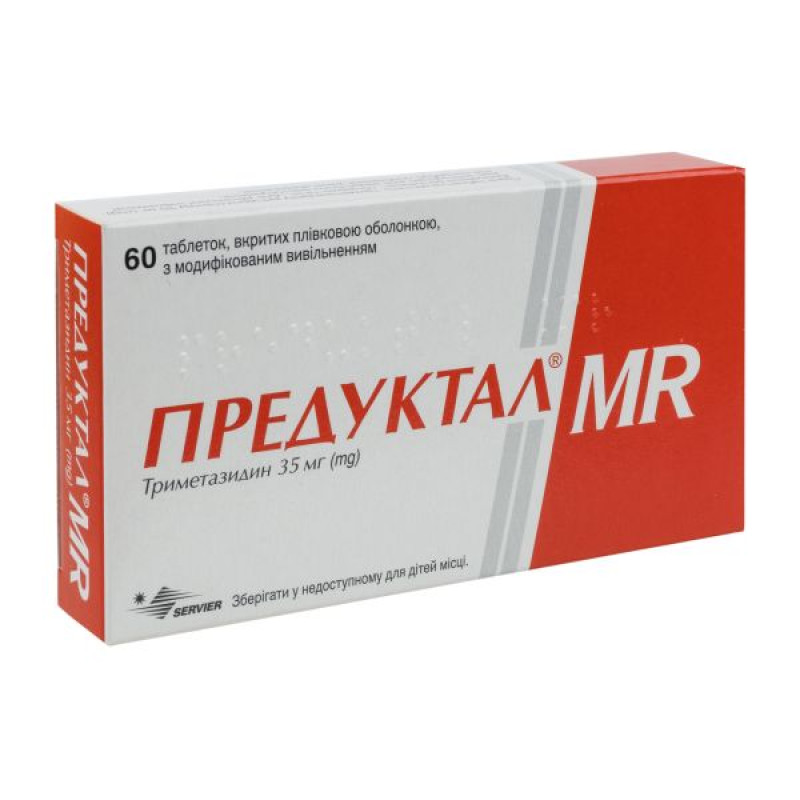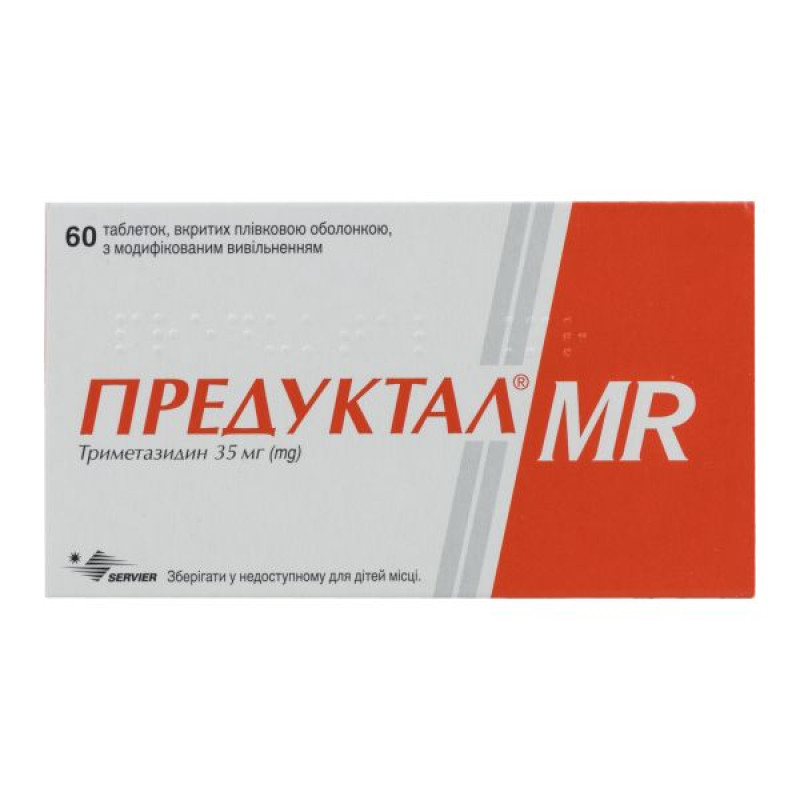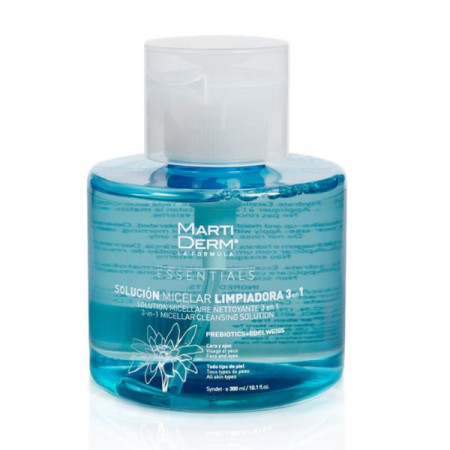Preductal MR film-coated tablets with modified release 35 mg blister No. 60

Instructions Preductal MR film-coated tablets with modified release 35 mg blister No. 60
Composition
active ingredient: trimetazidine;
1 tablet contains: trimetazidine dihydrochloride 35 mg;
excipients:
tablet: calcium hydrogen phosphate dihydrate, hypromellose 4000, magnesium stearate, povidone, colloidal anhydrous silicon dioxide;
shell: glycerol, macrogol 6000, magnesium stearate, hypromellose, red iron oxide (E 172), titanium dioxide (E 171).
Dosage form
Modified-release film-coated tablets.
Main physicochemical properties: pink, biconvex tablets, film-coated, with or without embossing on one side.
Pharmacotherapeutic group
Cardiological drugs. Trimetazidine. ATC code C01E B15.
Pharmacological properties
Pharmacodynamics
Mechanism of action
By preserving energy metabolism in cells suffering from hypoxia or ischemia, trimetazidine prevents a decrease in intracellular ATP levels, thereby ensuring the proper functioning of ion pumps and transmembrane sodium-potassium flux while maintaining cellular homeostasis.
Trimetazidine inhibits β-oxidation of fatty acids by blocking long-chain 3-ketoacyl-CoA thiolase (3-CAT), which increases glucose oxidation. In cells under ischemic conditions, the process of obtaining energy through glucose oxidation requires less oxygen compared to the process of obtaining energy through β-oxidation of fatty acids. Strengthening the process of glucose oxidation optimizes energy processes in cells and, accordingly, maintains sufficient energy metabolism under ischemic conditions.
Pharmacodynamic effects
In patients with ischemic heart disease, trimetazidine acts as a metabolic agent, maintaining intracellular levels of high-energy phosphates in the myocardium. Anti-ischemic effects are achieved without concomitant hemodynamic effects.
Clinical efficacy and safety
Clinical studies have demonstrated the efficacy and safety of trimetazidine for the treatment of patients with stable angina both as monotherapy and when added to other antianginal drugs when they are insufficiently effective.
TRIMPOL-II study. A randomized, double-blind, placebo-controlled study in 426 patients demonstrated that the addition of trimetazidine 60 mg daily to metoprolol 100 mg (50 mg twice daily) for 12 weeks resulted in significant improvements in exercise test performance and clinical symptoms compared with placebo: total exercise duration - +20.1 s, p=0.023; total work performed - +0.54 MET s, p=0.001; time to 1 mm ST-segment depression - +33.4 s, p=0.003; time to angina attack - +33.9 s, p<0.001; number of angina attacks/week - -0.73, p=0.014; use of short-acting nitrates/week - -0.63, p=0.032, without changes in hemodynamic parameters.
SELLIER study. A randomized, double-blind, placebo-controlled study in 223 patients demonstrated that in a subgroup of patients (n=173) who were given trimetazidine, modified-release tablets, 35 mg (b.i.d.) to atenolol 50 mg (q.i.d.) for 8 weeks, there was a significant increase (+34.4 s, p=0.03) in the time to 1 mm ST-segment depression in exercise tests compared with placebo 12 hours after dosing. A significant difference in time to angina attack was also confirmed (p=0.049). There were no significant differences between the two groups for other secondary endpoints (total exercise duration, total work performed, and clinical endpoints).
VASCO study. In a 3-month, randomized, double-blind study of 1962 patients, trimetazidine 70 mg or 140 mg daily or placebo was added to atenolol 50 mg daily. In the overall population, which included both symptomatic and asymptomatic patients, trimetazidine did not demonstrate any benefit in either ergometric measures (total exercise time, time to 1 mm ST-segment depression, and time to angina attack) or clinical endpoints. However, a post hoc analysis of the subgroup of symptomatic patients (n=1574) showed that trimetazidine 140 mg/day significantly improved total exercise time (+23.8 s vs. +13.1 s placebo; p=0.001) and time to angina attack (+46.3 s vs. +32.5 s placebo; p=0.005).
Pharmacokinetics
The maximum concentration of trimetazidine in the blood is observed on average 5 hours after taking the tablet. The concentration in the blood plasma remains stable throughout the day: within 11 hours after taking the tablet, the concentration of trimetazidine in the blood plasma is equal to or higher than 75% of the maximum concentration. The steady-state concentration is reached no later than the 60th hour. Food intake does not affect the pharmacokinetic characteristics of trimetazidine.
Trimetazidine is excreted mainly in the urine, mainly unchanged. The half-life is on average 7 hours in healthy young volunteers and 12 hours in people over 65 years of age. The complete elimination of trimetazidine is mainly the result of renal clearance, which is directly correlated with creatinine clearance, and to a lesser extent is the result of hepatic clearance, which decreases with age.
Special patient groups
Elderly patients.
A special clinical study was conducted in elderly patients with the use of trimetazidine 35 mg (1 tablet) 2 times a day. The analysis performed by the kinetic population method showed an increase in plasma concentrations. In elderly patients, an increase in trimetazidine concentrations is possible due to age-related decline in renal function. A special pharmacokinetic study in patients aged 75-84 years or ≥ 85 years showed that in patients with moderate renal insufficiency (creatinine clearance 30-60 ml/min) the concentration of trimetazidine increased by 1.0 and 1.3 times, respectively, compared with younger patients (aged 30-65 years) with moderate renal insufficiency.
Renal impairment: The blood concentration of trimetazidine increases on average 1.7-fold in patients with moderate renal impairment (creatinine clearance 30-60 ml/min) and 3.1-fold in patients with severe renal impairment (creatinine clearance < 30 ml/min) compared to healthy volunteers with normal renal function. No additional safety concerns were observed in this population compared to the general population.
Indication
In adults, trimetazidine is indicated for the symptomatic treatment of stable angina pectoris when first-line antianginal drugs are ineffective or intolerant.
Contraindication
Hypersensitivity to the active substance or to any of the excipients. Parkinson's disease, parkinsonian symptoms, tremor, restless legs syndrome and other movement disorders related to the above. Severe renal failure (creatinine clearance < 30 ml/min).
Interaction with other medicinal products and other types of interactions
No interactions with other drugs have been reported.
Application features
This medicinal product is not intended for the relief of angina attacks. It should not be prescribed for unstable angina or myocardial infarction as primary therapy in the pre-hospital stage or in the first days of hospitalization.
In the event of an attack of unstable angina during current therapy, it is necessary to review the patient's disease status and adjust the treatment (drug therapy and the possibility of revascularization).
Trimetazidine may cause or worsen parkinsonism symptoms (tremor, akinesia, muscle hypertonia), which should be regularly monitored, especially in elderly patients. In doubtful cases, patients should be referred to a neurologist for appropriate examinations.
If movement disorders appear, such as symptoms of parkinsonism, restless legs syndrome, tremor, or gait instability, trimetazidine should be discontinued.
These cases have a low incidence and usually disappear after discontinuation of treatment; in most patients, within 4 months of discontinuation of trimetazidine. If parkinsonism symptoms persist for more than 4 months after discontinuation of the drug, a neurologist should be consulted.
Falls associated with gait instability or hypotension may occur, especially in patients receiving antihypertensive treatment (see section "Adverse reactions").
Trimetazidine should be prescribed with caution to patients at risk of increased concentrations:
patients with moderate renal insufficiency (see sections “Method of administration and dosage” and “Pharmacokinetics”);
elderly patients aged 75 years and over (see section "Method of administration and dosage").
Ability to influence reaction speed when driving vehicles or other mechanisms
According to clinical studies, trimetazidine does not affect hemodynamics, however, in the post-marketing period, cases of dizziness and drowsiness were recorded (see section "Adverse reactions"), which may affect the ability to drive and use machines.
Use during pregnancy or breastfeeding
Pregnancy
There are no data on the use of trimetazidine in pregnant women. Animal studies do not indicate direct or indirect harmful effects with respect to reproductive toxicity. In order to avoid any risk, the use of trimetazidine during pregnancy is not recommended.
Breast-feeding
It is not known whether trimetazidine or its metabolites pass into breast milk. To avoid any risk to newborns/infants, the use of PREDUCTAL® MR is not recommended during breastfeeding.
Method of administration and doses
For oral use.
1 tablet of 35 mg of trimetazidine 2 times a day, morning and evening, during meals.
After 3 months of treatment, the results of treatment should be evaluated and, if there is no effect, trimetazidine should be discontinued.
Special patient groups
For patients with moderate renal insufficiency (creatinine clearance 30-60 ml/min), the recommended dose is 1 tablet per day in the morning during breakfast (see sections "Special instructions for use" and "Pharmacokinetics").
Elderly patients
In elderly patients, an increase in the concentration of trimetazidine in the blood is possible due to age-related decline in renal function (see section "Pharmacokinetics"). For patients with moderate renal insufficiency (creatinine clearance - 30-60 ml/min), the recommended dose is 1 tablet of 35 mg in the morning during breakfast.
For elderly patients, the dose should be titrated with caution (see section "Special warnings and precautions for use").
Children
The safety and efficacy of trimetazidine in children (under 18 years of age) have not been studied. Data are not available.
Overdose
There is limited data on overdose with trimetazidine. Treatment is symptomatic.
Adverse reactions
Adverse reactions that have been identified as possible adverse reactions related to the use of trimetazidine are listed below according to the frequency assigned:
very common (≥ 1/10); common (≥ 1/100, < 1/10); uncommon (≥ 1/1000, < 1/100); rare (≥ 1/10000, < 1/1000); very rare (< 1/10000); frequency unknown (cannot be estimated from the available information).
| Classification by organ systems | Frequency | Adverse reaction |
| From the nervous system | Often | Dizziness, headache |
| Frequency unknown | Parkinsonism symptoms (tremor, akinesia, muscle hypertonia), gait instability, restless legs syndrome and other movement disorders related to the above, which usually resolve after discontinuation of treatment | |
| Sleep disorders (insomnia, drowsiness) | ||
| From the side of the organs of hearing and vestibular apparatus | Frequency unknown | Vertigo |
| From the heart | Rarely | Palpitations, extrasystole, tachycardia |
| From the vascular side | Rarely | Hypotension, orthostatic hypotension, which may be associated with malaise, dizziness or fall, especially in patients taking antihypertensive drugs, facial flushing |
| From the digestive tract | Often | Abdominal pain, diarrhea, dyspepsia, nausea and vomiting |
| Frequency unknown | Constipation | |
| Skin and subcutaneous tissue disorders | Often | Rash, itching, hives |
| Frequency unknown | Acute generalized exanthematous pustulosis, angioedema | |
| General violations | Often | Asthenia |
| Blood and lymphatic system disorders | Frequency unknown | Agranulocytosis, thrombocytopenia, thrombocytopenic purpura |
| Hepatobiliary system | Frequency unknown | Hepatitis |
Expiration date
3 years.
Storage conditions
Does not require any special storage conditions. Keep out of the reach of children.
Packaging
30 tablets in a blister (PVC/aluminium); 2 blisters in a cardboard box.
Vacation category
According to the recipe.
Producer
Servier Industrie Laboratories.
Location of the manufacturer and its business address
905 route de Saran, 45520 Gidy, France/905 route de Saran, 45520 Gidy, France.
There are no reviews for this product.
There are no reviews for this product, be the first to leave your review.
No questions about this product, be the first and ask your question.










